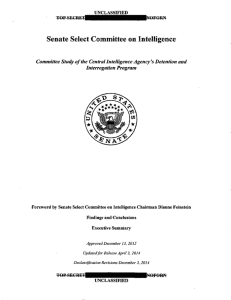On Dec. 9, 2014, a six thousand page report was released to the public listing criminal offenses of the Central Intelligence Agency’s Detention and Interrogation Program. This report, compiled by the United States Senate Select Committee on Intelligence, has unsettled many people across the globe.
The first point of the report concludes that many of the techniques used by the CIA were ineffective. The report also reads as follows: “Other detainees provided significant accurate intelligence prior to, or without having been subjected to these techniques” (2).
Not only were many interrogations stretched to excessively harsh means, but detainees were claimed to have been treated brutally and subjected to strenuous conditions. According to section 3 of the report, “Sleep deprivation involved keeping detainees awake for up to 180 hours, usually standing or in stress positions, at times with their hands shackled above their heads.”
In addition to the questionable actions of the CIA, there are many accusations in the documents that claim that the CIA has avoided attention from the White House and Executive Branch agencies.
The main subject of controversy is the validity of the CIA’s interrogation techniques. Some argue that torture is inhumane, unethical, and unconstitutional, while others speculate that it is necessary to extract vital information.
Granted, some of the CIA’s objectives include going to any extreme to protect the nation, which is often where the lines are blurred.The CIA’s first detainee, Abu Zubaydah, was a suspected al-Qaeda prisoner subjected to waterboarding numerous times during his interrogations.
Waterboarding is just one of the techniques used by interrogators, and gives the detainee the sensation of drowning. Water is poured over a cloth on the face, making it difficult to breathe. Zubaydah’s side effects from this procedure were physically harmful and even left him briefly unresponsive.
In 2007, CIA member John Kiriakou released information to a reporter concerning the torture of suspected al-Qaeda prisoners. In the wake of the September 11 terrorist attack, Kiriakou felt that the interrogations possibly saved lives, but he later claimed to view the act as tortuous.
As terrorism becomes more widespread and complicated, many are questioning whether the techniques the CIA uses should be supported. To read the full text of the Committee Study of the Central Intelligence Agency’s Detention and Interrogation Program, follow this link.
